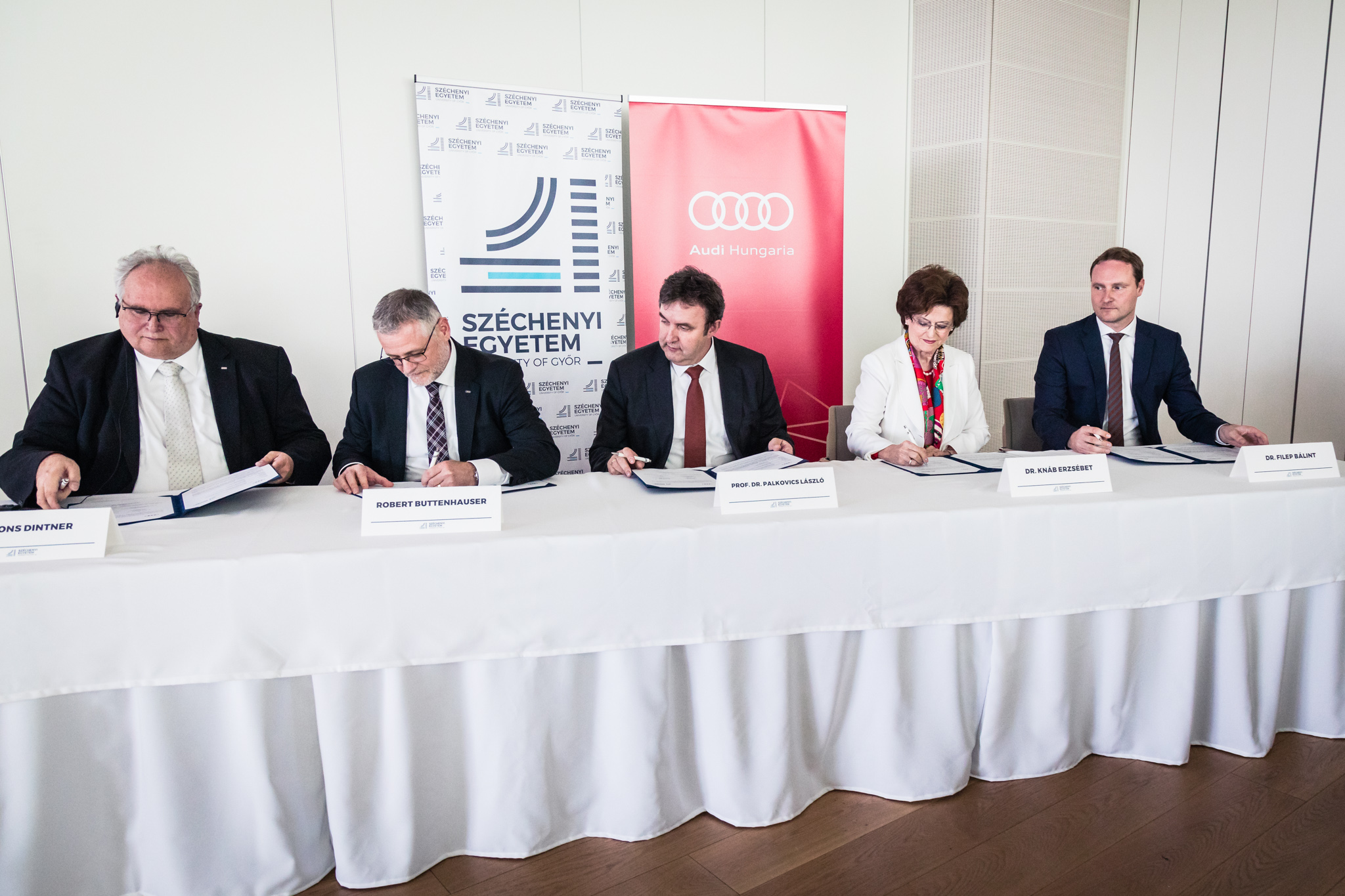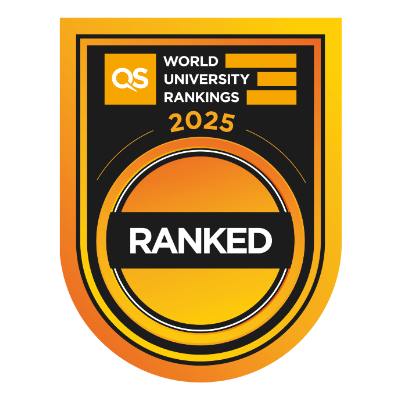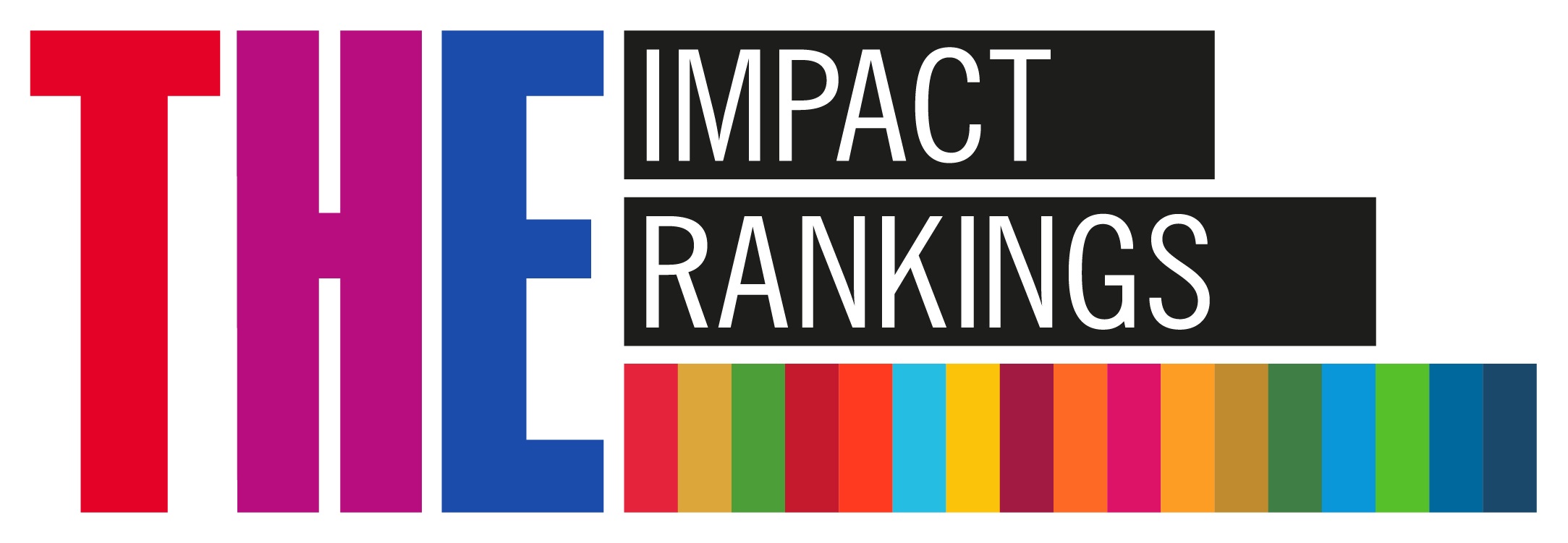Innovation projects: cooperation between Széchenyi István University, Audi and University of Szeged
Széchenyi István University, with the support of the Ministry of Innovation and Technology, has entered into a forward-looking cooperation with Audi Hungaria Zrt. and the University of Szeged. The joint innovation projects will focus on research and validation of alternative fuels, exploring the industrial potential of hydrogen and reducing carbon dioxide emissions.
Together for innovation: Széchenyi István University will work on innovative sustainability projects with Audi Hungaria Zrt. of Győr and the University of Szeged.
The cooperation agreements were signed on Thursday by Dr Erzsébet Knáb, Chair of the Board of Trustees of the Széchenyi István University Foundation, Dr Bálint Filep, President of Széchenyi István University, Dr László Palkovics, Minister of Innovation and Technology, Alfons Dintner, Chairman of the Board of Directors of Audi Hungaria, Robert Buttenhauser, Member of the Board of Directors of Audi Hungaria responsible for engine production, and Dr Gábor Szabó, President of the University of Szeged Foundation at the ZalaZONE automotive test track, Zalaegerszeg.
The projects will focus on research and validation of alternative fuels, exploring the potential of hydrogen for industrial applications and reducing carbon dioxide emissions.
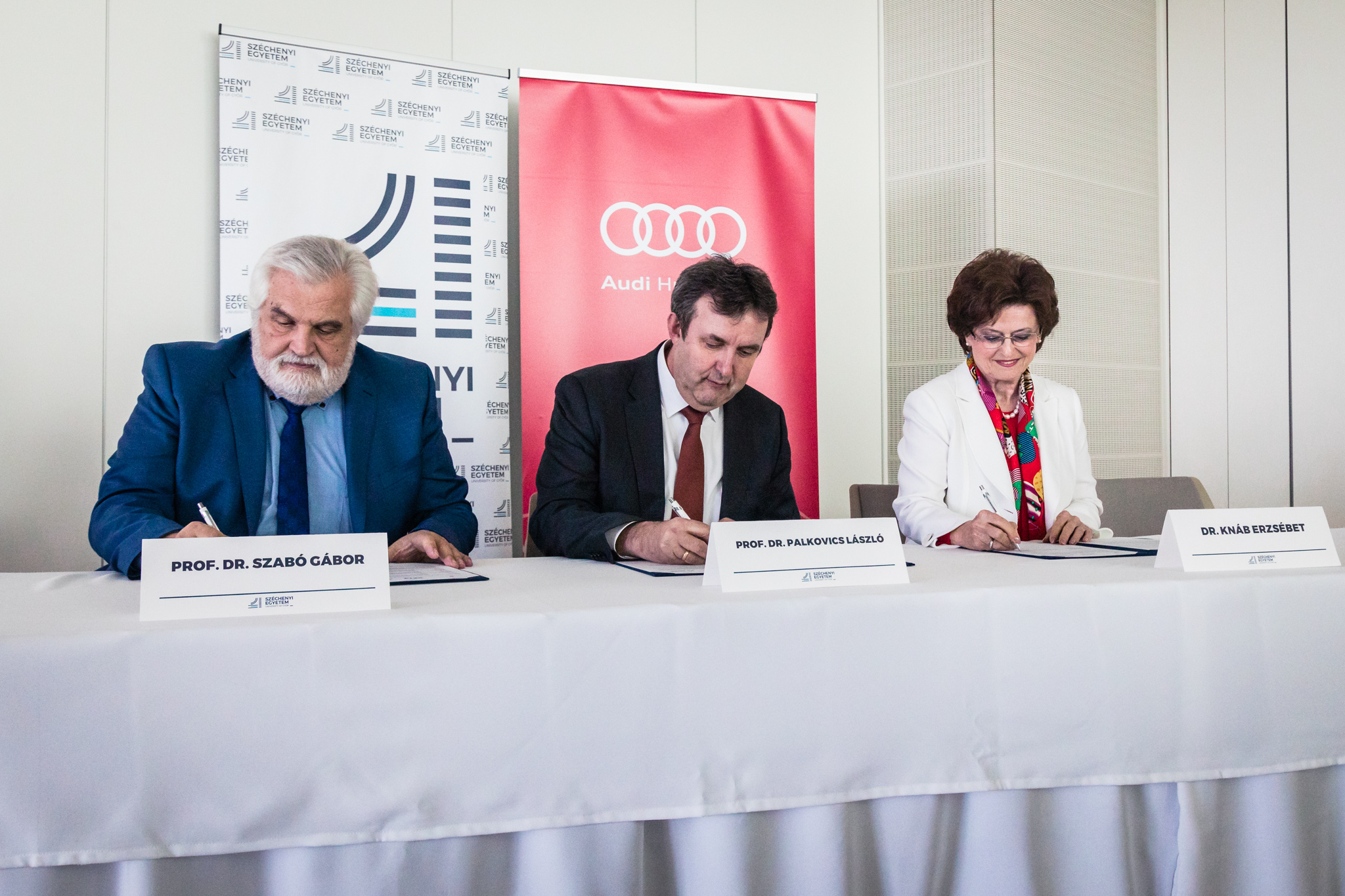
The second cooperation agreement was signed by Alfons Dintner, Robert Buttenhauser, Dr László Palkovics, Dr Erzsébet Knáb and Dr Bálint Filep. (Photo by József Csaba Májer)
Dr László Palkovics pointed out that a few years ago, experts saw the future of mobility in purely electric propulsion, but today the picture has become more nuanced. Something must be done to make existing vehicles more environmentally friendly, and the potential of hydrogen as a fuel and energy storage medium should be explored. The minister said that greening transport is a key element of the government's climate and nature action plan, announced two years ago. Over the past period, the purchase of more than 15,000 electric vehicles has been subsidised via tenders, and the number of vehicles with green plates has increased from 28,000 to 43,000 in less than a year.
Dr Erzsébet Knáb, Chair of the Board of Trustees of the Széchenyi István University Foundation, stressed that the knowledge and innovation potential concentrated at Széchenyi István University is one of the driving forces of the economic development of the region and the country.
"The aim of our institution is to play an even more prominent role in linking the economic and scientific spheres through cooperation with industrial players, by creating an innovation ecosystem that helps to increase the competitiveness of companies. We are delighted that thanks to the research projects launched with the support of the Ministry of Innovation and Technology, our exemplary strategic partnership with Audi Hungaria can take on a new dimension, strengthen our relations with the University of Szeged and contribute to the development of the automotive industry and our country", added Dr Knáb.
"In its new Next level strategy, Audi Hungaria has set itself the goal of taking its activities to a new level in order to ensure the long-term success of the company. This ambition also applies to the area of scientific cooperation. Our company has been successfully cooperating with Széchenyi István University for many years, and today's cooperation agreement will strengthen this cooperation even further. I believe that the experience of our experts and the knowledge concentrated at the University, as well as the support of the Ministry of Innovation and Technology, will result in innovative and forward-looking solutions that will contribute to strengthening the competitiveness of our company and the country as a whole," said Alfons Dintner, Chairman of the Board of Directors of Audi Hungaria.
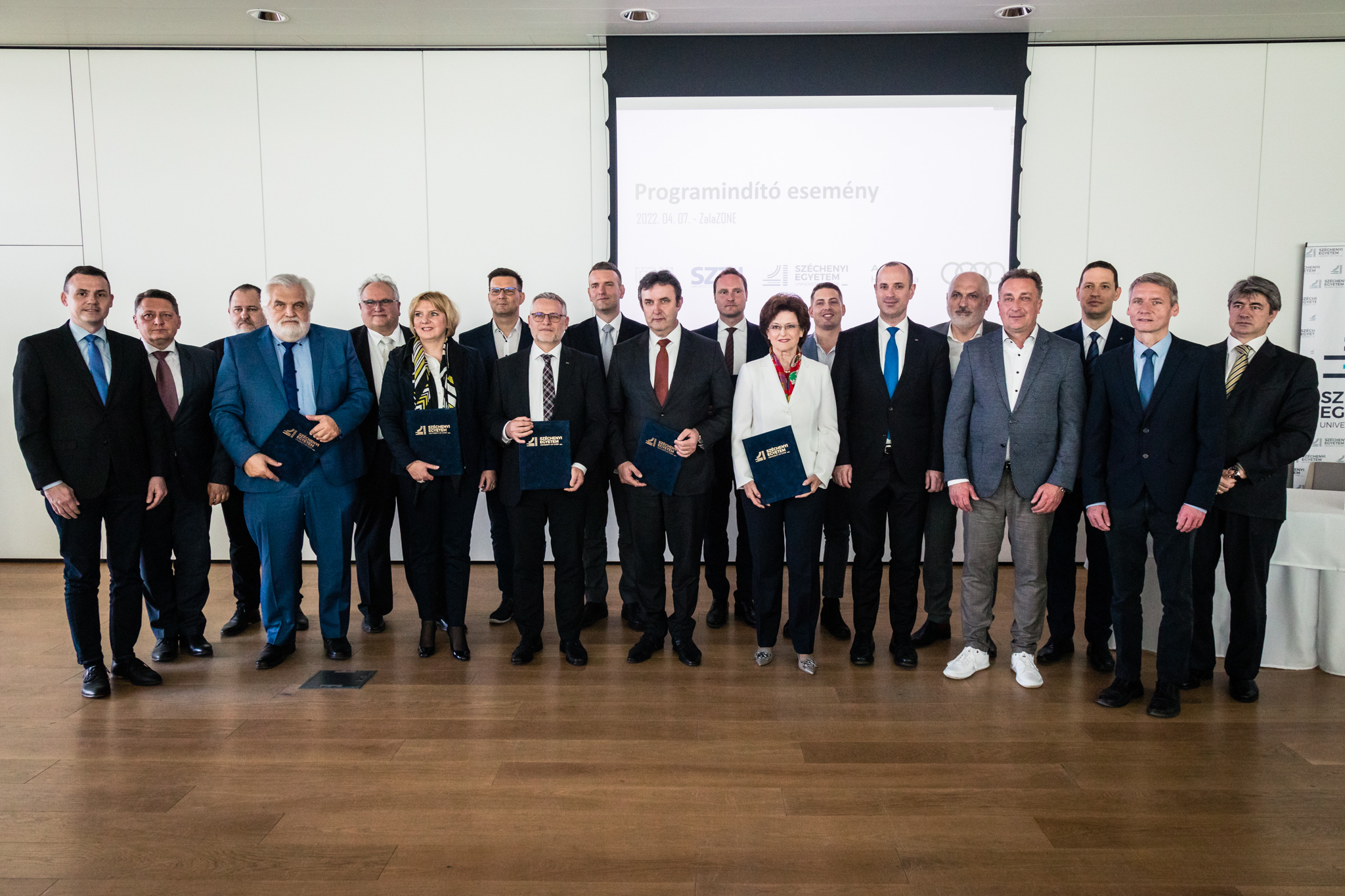
Dr Gábor Szabó, President of the University of Szeged Foundation, expressed his pleasure that they could be part of such a forward-looking development. "On the one hand, we will be working on a group of topics directly related to propulsion and engines, and on the other hand, on the production of alternative fuels. All this is a good example of how the competences of our institution can be combined and exploited," he said. Zoltán Kónya, Vice Rector for Science and Innovation at the University of Szeged, related how they are developing a flexible pilot plant, unique at European level, to test and grade the various catalytic converters, reactors and cells for the production of synthetic fuels in a validated way, simulating industrial conditions.
Robert Buttenhauser, Member of Audi Hungaria’s Board of Management responsible for engine production explained that the development and validation of alternative fuels, including synthetic fuels, is being investigated in various research projects. As part of this, the industrial use of hydrogen is also being investigated and piloted. In addition, particular emphasis is being placed on research and implementation of a comprehensive carbon neutralisation process.
Dr László Amand Palkovics, Professor at the Széchenyi István University Faculty in Mosonmagyaróvár, explained that the project also includes the development of a pilot sustainable greenhouse environment to explore the utilisation of carbon dioxide captured from the atmosphere. The idea is that high carbon dioxide levels can lead to a 30 percent increase in yields.
The joint innovation projects are expected to be completed in 2025.

In connection with the signing ceremony, Széchenyi István University demonstrated its increasingly strong presence in ZalaZONE. The institution's Automotive Research Centre (JKK), in collaboration with the Digital Development Centre (DDC) and the Computer Science and Automation Research Institute (SZTAKI), showed a section of its research and development: the audience saw a self-driving car autonomously avoid, without intervention, several obstacles composed of vehicles, and did the same when supplemented with a drone, by using its sensor data. JKK's ZalaZONE unit also demonstrated a radar cross-sectional measurement in preparation for future industrial R&D. In addition, the guests were able to see a special leg interface application, jointly developed by Talaris Ltd. and the University, where university researcher György Lévay, Hungary's ambassador of artificial intelligence, piloted a large-scale Hexacopter using only his legs. Finally, the programme concluded with a demonstration of a custom-built FPV (first-person-view) drone, capable of spectacularly high dynamics, in which the pilot controlled the flight using a live image transmitted from the craft.









